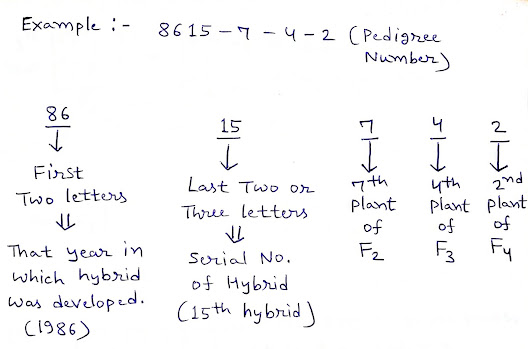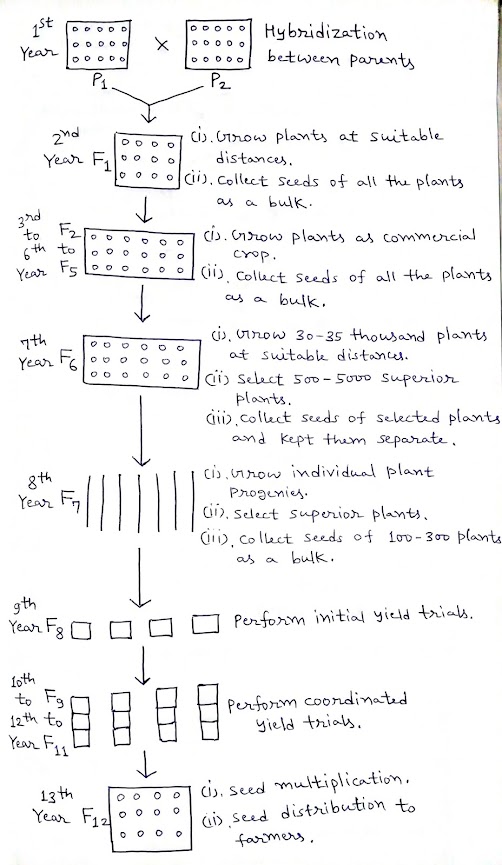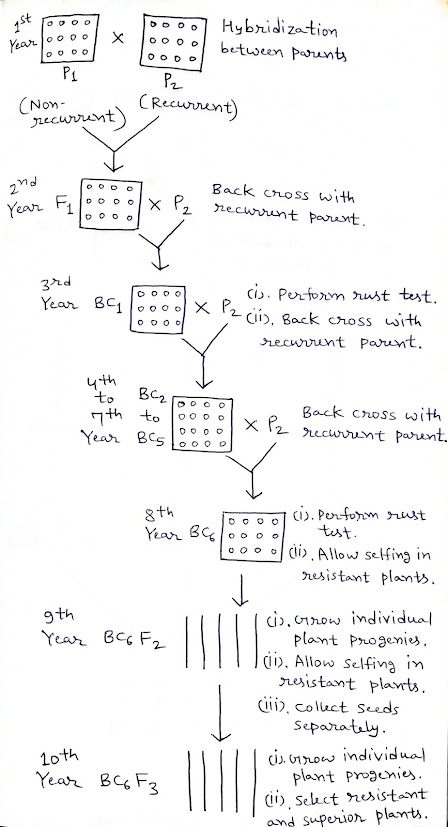Handling of Segregating Populations
UPDATED ON:- 01-01-2024
Handling:- संकरण से प्राप्त संकर बीजों को उगाकर F1 पीढ़ी प्राप्त की जाती है। इस F1 पीढ़ी में स्वपरागण कराकर क्रमश: F2, F3, F4, F5, F6 आदि पीढ़ियाँ उगाई जाती हैं जिन्हें विसंयोजी समष्टियाँ कहते हैं।इनमें आनुवांशिक विविधता उपस्थित होती है। इन समष्टियों से वरण द्वारा फसल सुधार करने की प्रक्रिया को Handling कहते हैं।
जैसे जैसे वरण होता जाता है, वैसे वैसे इन विसंयोजी समष्टियों में विषमयुग्मनजता कम होती जाती है। जैसा कि नीचे diagram में प्रदर्शित किया गया है।
(F1 generation is obtained by growing hybrid seeds obtained from hybridization. By doing self crossing in F1 generation plants, other generations as F2, F3, F4, F5, F6 etc. are created respectively are called as segregating populations. They have genetic diversity. The process of crop improvement through selection from these populations is called Handling.
As the selection progresses, the heterozygosity decreases in these segregating populations. As shown in the diagram below.)
Handling की विधियाँ (Methods of Handling):- F1 संकर की विसंयोजी समष्टियों में वरण निम्न तीन विधियों द्वारा किया जाता है:-
(In segregating populations of F1 hybrids, selection is done by the following three methods: -)
1. वंशावली विधि (Pedigree Method)
2. पुंज विधि (Bulk Method)
3. प्रतीप संकरण विधि (Back Cross Method)
1. वंशावली विधि
(When individual plant progenies are grown and their records are kept safe, it is called pedigree method.)
वंशावली संख्या (Pedigree Number):- यह नई विकसित किस्म की वंशावली को प्रदर्शित करती है। एक उदाहरण नीचे diagram में प्रदर्शित किया गया है।
(It shows the lineage of the newly developed variety. An example is displayed in the diagram below.)
व्यापीकृत रूपरेखा (Generalized Outline):-
चेक किस्म (Check variety):- स्थानीय उन्नत किस्म जिसके निष्पादन की तुलना नई किस्म के साथ करते हैं, चेक किस्म कहलाती है।
(The local improved variety whose performance is compared with the new variety is called the Check variety.)
शटल प्रजनन (Shuttle Breeding):- जब विसंयोजी पीढ़ियों को 2 भिन्न स्थानों पर एकांतरित रूप से उगाते हैं तो इसे शटल प्रजनन कहते हैं। जैसा कि नीचे दियाग्राम में प्रदर्शित किया गया है।
(When the segregating populations are grown in 2 different places alternatively, then it is called shuttle breeding. As displayed in the diagram below.)
2. पुंज विधि (Bulk Method):- जब विसंयोजी पीढ़ियों को व्यापारिक फसल कि भांति उगाकर सभी पौधों के बीजों को पुंज में एकत्रित कर लिया जाता है तो इसे पुंज विधि कहते हैं। इस विधि का सबसे पहले उपयोग Nilsson Ehle ने 1908 में किया था।
(When the segregating populations are grown as a commercial crop and the seeds of all plants are collected into a mass, then it is called the bulk method. The method was first used by Nilsson Ehle in 1908.)
व्यापीकृत रूपरेखा (Generalized Outline):-
SSD विधि (Single Seed Descent Method / एकल बीज वंश विधि):-
• यह पुंज विधि का एक सरल व सक्षम रूपान्तरण है।
(This is a simple and efficient conversion of the bulk method.)
• परिभाषा (Definition):- जब विसंयोजी पीढ़ियों को व्यापारिक फसल कि भांति उगाकर प्रत्येक पौधे से एक बीज लेकर पुंज में एकत्रित कर लिया जाता है तो इसे एकल बीज वंश विधि कहते हैं।
(When the segregating populations are grown as a commercial crop and one seed from each plant is taken and collected as a mass, it is called the single seed descent method.)
• इस विधि में F2 पीढ़ी में सभी पौधों से एक एक बीज लेकर इन्हें मिश्रित कर पुंज का निर्माण करते हैं। इस मिश्रण से F3 पीढ़ी उगाते हैं। जैसा कि नीचे diagram में दिया गया है।
(In this method, in F2 generation, one seed from each plant is taken and mix them to make a mass. F3 generation is grown from this mixture. As given in the diagram below.)
व्यापीकृत रूपरेखा (Generalized Outline):- यह पुंज विधि के समान ही है। केवल F2 से F6 पीढ़ी के बिन्दु (ii) में परिवर्तन है।
[This is very similar to the bulk method. Only (ii). point is changed in F2 to F6 generation.]
3. प्रतीप संकरण विधि (Back Cross Method):-
• परिभाषा:- जब F1 पीढ़ी के पौधों का किसी एक जनक से बार बार प्रतीप संकरण कराया जाता है, तो इस विधि को प्रतीप संकरण कहते हैं। इसके फलस्वरूप नई किस्म का जीन प्रारूप उस जनक के लगभग एक समान हो जाता है।
(When F1 generation plants are repeatedly crossed with one parent plants, this method is called backcross method. As a result, the genotype of the new variety is almost identical to that of the parent.)
• आवर्ती जनक या आदाता जनक (Recurrent Parent or Recipient Parent):- जिस जनक के साथ F1 पीढ़ी का बार बार प्रतीप संकरण कराया जाता है। यह उत्कृष्ट जनक होता है। इसमें केवल एक विशिष्ट लक्षण की कमी होती है।
(The parent with whom the F1 generation plant is repeatedly crossed up. It is an superior parent. It lacks only one specific trait.)
• अनावर्ती जनक या दाता जनक (Non - recurrent Parent or Donor Parent):- अन्य जनक। यह उत्कृष्ट या निकृष्ट हो सकता है। जिस लक्षण की आदाता जनक में कमी होती है, वह इस जनक में उच्च परिमाण में उपस्थित होता है।
जैसे जैसे प्रतीप संकरण होता जाता है वैसे वैसे आवर्ती जनक के जीनों की आवृति बढ़ती जाती है। जैसा कि नीचे flowchart व सारणी में प्रदर्शित किया गया है।
(Other parent. It can be superior or inferior. The trait which is deficient in the recipient parent is present in a higher proportion in this parent.
As the back cross progresses, the frequency of the genes of the recurring parent increases. As shown in the flowchart and table below.)
व्यापीकृत रूपरेखा (Generalized Outline):-





















